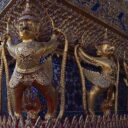Bangkok or Krung Thep (City of Angels) was founded in 1782 by King Rama I, the first king of the Chakri Dynasty. The new capital is a replica of Ayutthaya, with its palace and royal temple following the same tradition and architectural style.
The royal temple, Wat Phra Kaew, was built in 1785 for two main purposes: to house the highly revered Buddha image known as The Emerald Buddha, and to accommodate royal Buddhist ceremonies.
The Buddha, carved from a block of green jade, was discovered in 1434 in a stupa in Chiang Rai province in northern Thailand. Every year as a royal tradition, the Buddha image’s attire has to be changed by the king in summer, rainy season and cold season.
There are several interesting structures within the compound, for example, Phra Sri Rattanajedi – a golden bell-shaped pagoda which holds relics of the Lord Buddha, and the Royal Pantheon – a magnificent pavilion with corn-shaped summit, constructed to commemorate the great kings of the Chakri Dynasty.
The walls around the temple are decorated with beautiful mural paintings based on a well-known literature, Ramayana. They were first painted during the reign of King Rama I, but several major restorations have taken place after that to counter the damage from moisture.
A gateway connects Wat Phra Kaew and the Grand Palace which was established in 1782. It served as a royal residence until 1925. Its most famous throne hall is the Chakri Maha Prasat, built in 1882 during the reign of King Rama V who had been on several visits to Europe. The throne hall has quite a unique architecture: the body of a Victorian style building covered with an authentic Traditional Thai style roof.
The Grand Palace, together with the royal temple, is one of the most popular tourist attractions in Bangkok as it attracts travellers from all over the world.
When ceremonies take place some parts may be closed to the public, further details on our blog post with opening days of Grand Palace and Wat Phra Kaew.
























